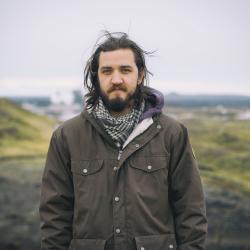Famous for rapid-fire drum ‘n’ bass tunes, electronic artist Futuregrapher—real name Árni Grétar—has made a name for himself as a great live performer, collaborated with numerous artists, and released three albums of his own. His fourth upcoming album, ‘Hrafnagil’ (“Raven Ravine”), is a far more personal affair than previous works, and serves as an ode to his home town of Tálknafjörður, where he first started making music.
Árni says the album is very minimalistic and full of repetition, with songs and themes evolving through subtle note changes, “like a painting, but through tones.” The ravine the album is named after sits in Tálknafjörður, and Árni says he’s always felt a calling to it, no matter where he is. “Even after moving to Reykjavík, I’ve felt like ravens have followed me, keeping an eye on me,” he says. Árni confides that his first album ‘LP’ was supposed to be called Hrafnagil, but he changed the name last minute because its high-speed drum ‘n’ bass jungle beats didn’t fit with his connection to that place—Hrafnagil is where he and his friends would play together, and it’s not far from where his parents were laid to rest. To Árni, Hrafnagil is a waking memory that evokes a very particular kind of beauty, which is why he smilingly says: “I’m relieved to finish this album so I can get back to making some other nonsense.”
We invited Árni to talk us through each of the songs on his album. What follows is a lightly edited transcript.
[bandcamp width=400 height=700 album=2648282973 size=large bgcol=ffffff linkcol=0687f5]Pollurinn
This song contains a recording I took from three hot pots in Litli-Laugardalur. It’s a tourist spot a while away from town that the locals frequent. It’s a very minimalistic song with an ambient tone and a slow beat. It gives the same feeling as lying cool as a cucumber in the pots.
Þórsberg
That’s the fish processing plant where I worked in my youth, but it’s closed down since. It’s the only song on the album with an acid techno tinge, some 303, and a faster pace. I was thinking back to my days of working with the Polish workers when I made this song.
Móatún
That’s the name of the street I grew up on; it’s the highest street in town, where many of my friends lived, and where I spent most of my youth. The song is a continuous eight-minute beat that doesn’t stop or slow down. It’s very mystical and ambient, which is just like what Móatún was like: the flow never stopped.
Suðureyri
This is a town on the other side of the fjord, which was inhabited more than a hundred years ago, and still houses the remnants of a whaling station, where Norwegians hunted. The song is very fragile, but in a beautiful way, and reminds me of standing in those ruins, in something that could have become something more.
Innsta-Tunga
That was the family home of one of my best friends, where we started the band Equal, and spent all of our waking hours practicing in the garage. We went together on a legendary trip to Reykjavík to compete in Músiktilraunir (Iceland’s “Battle of the Bands”), where we made it to the finals. We then later won in the category of best computer music, which is now called best electronic music, that I personally award today. The song is called that because it’s filled with emotions, and there were a lot of emotions made in that garage.
Útnaust
This is a salt fish factory that friends of the family owned and ran, and was where I worked in ’97, which was my favourite year in music. It’s an anchor to the past; I was fourteen, at an age when I thought I knew everything, and the song is filled with very dirty synth sounds that make me think back to the clank of the fish guillotine that decapitated the cod.
Stóri-Laugardalur
This is where my mother and father rest. The song contains a sound sample of my son Jói saying: “hey dad, listen dad, that’s how life is.” He says it jokingly, but there’s something about how he does it that struck me, like it comes straight from the core of his soul, that he’s saying it’ll be okay even if things are the way they are. I lost my parents at a young age, yet here he is, seven years old, telling me that’s life, and in such a beautiful tone. That sample gets played in the beginning and the end of the song, and it’s why I called it “Stóri-Laugardalur,” because it makes me think of my parents.
Hóll
This is, in my opinion, the most beautiful song. Hóll was a small farm 150 years ago and is where everything began. My great grandfather came from there, and it’s now the site of the new church. That’s where I was with my son when he said that’s how life is. It all comes back to this point, and the song is allowed to play until it reaches its natural conclusion.
Buy subscriptions, t-shirts and more from our shop right here!

















